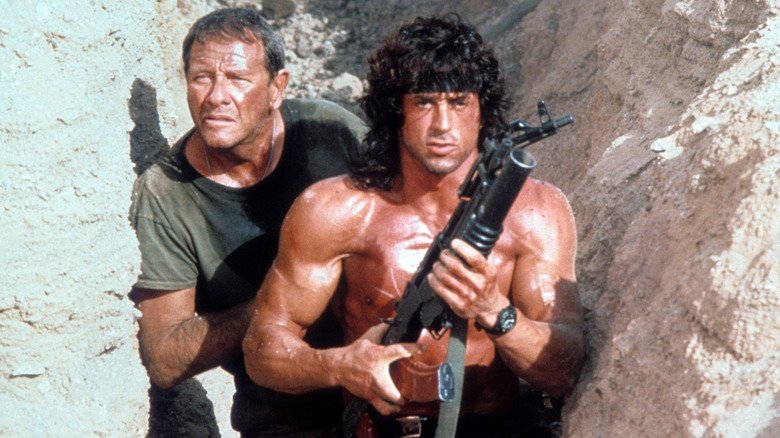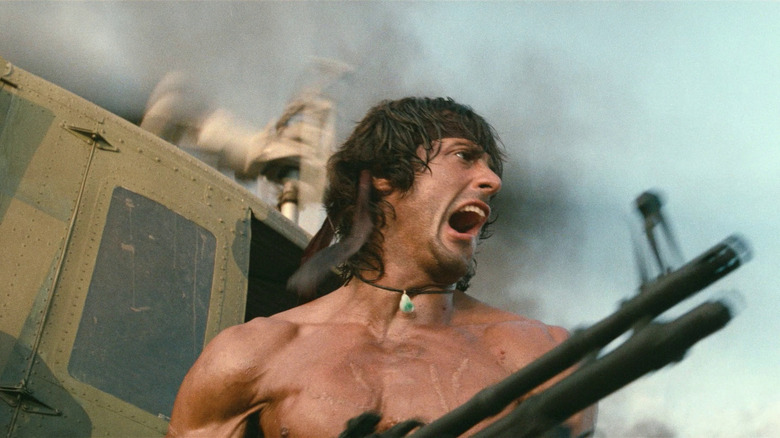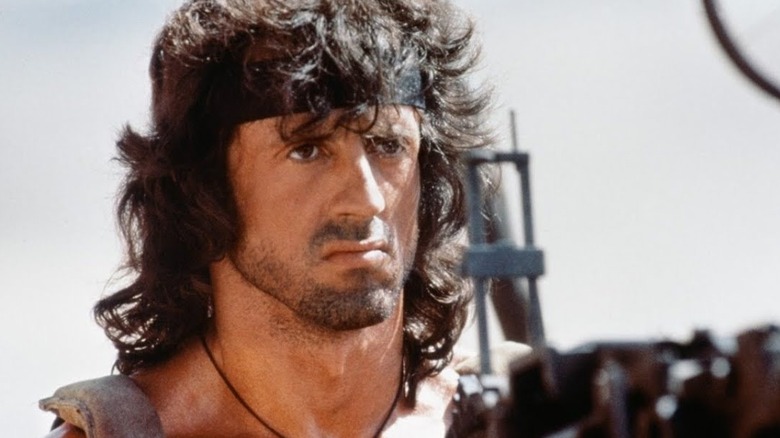Behind-The-Scenes Chaos Gave Rambo III's Director His Debut
There's a saying that luck is what happens when preparation meets opportunity. That was certainly the case for "Rambo III" director Peter MacDonald. A bizarre series of events led to a break that resulted in his directorial debut on a movie starring one of Hollywood's biggest action stars, Sylvester Stallone.
"First Blood" was the first film in the "Rambo" franchise, debuting in 1982. The movie examines the mistreatment of veterans and their struggle to reintegrate into society. The sequel, "Rambo: First Blood Part II," looks at the Vietnam War POW/MIA dispute. By the time "Rambo III" came along, it seems nobody was quite sure what it should be. At least not at first.
In the third film of the franchise, John Rambo has found peace among monks in Thailand when he's forced into Russian-controlled Afghanistan to rescue his old friend, Colonel Trautman (Richard Crenna). It's a departure from the social issues addressed in the franchise's earlier offerings and created destruction both on screen and behind the scenes with a production that Stallone described as a "runaway train."
Nearly the entire production crew was fired
While "Rambo III" was in production, the Los Angeles Times tried to piece together the behind-the-scenes puzzle. Sources they spoke to on set blamed a lack of vision for the film, crew conflicts, and even clashes with Sylvester Stallone. After more than two weeks of filming, the conflicts finally boiled over, causing massive changes to the production. The first domino to fall was when director of photography Ric Waite was replaced by P. David Gurfinkel, who had a history with Stallone as the DP for his 1987 arm wrestling movie "Over the Top." After that, a chain reaction of replacements followed.
All told, the film's director, assistant director, director of photography, and the entire camera crew were replaced. "Rambo III" second unit director Peter MacDonald took over as the film's director. It was MacDonald's first time at the helm of a film. If you listen to Stallone and read between the lines, it sounds like preparation was a big point of contention. The actor told the LA Times:
"The canvas of this movie is so large you have to constantly think 10 scenes ahead. You can't wing it. They didn't go into the Battle of Waterloo not knowing what their strategy would be. Well, this movie is kind of like cinematic warfare. We have a huge cast and crew and tough locations to deal with. Everyone and everything has to coordinate."
Ousted director Russell Mulcahy, a veteran music video director who had previously directed 1984's "Razorback" and 1986's "Highlander," had been handpicked by Stallone for "Rambo III." And once he was gone, there was no guarantee MacDonald would take the job.
MacDonald had to be talked into taking the job
Despite the opportunity to direct one of the 1980s hottest action movies with Sylvester Stallone, Peter MacDonald still wasn't sure he wanted the gig. And you can't blame him. Filming took place in Israel near the Dead Sea with temperatures around 120 degrees Fahrenheit, and the movie was on life support.
But Stallone knew what he had in MacDonald, who was also the second unit director for "Rambo II." Stallone called MacDonald one of the best camera operators in the world and said MacDonald's action scenes from "Rambo II" were some of the best in the film. Still, it took some convincing from Stallone. MacDonald explained to the LA Times:
"Sly convinced me that with what he knows about his character and with the support of everyone that we could make it work. Sly and the producers had more trust in me than I had in myself."
The gamble on MacDonald paid off, at least at the box office. "Rambo III" would gross nearly $190 million worldwide. By 1988, it was no shock that the film was not a critical success. By the third iteration, Rambo had morphed from a sort of a social problem film to a full-on 1980s blockbuster explosion-fest, a caricature of its origins. The Washington Post went so far as to say the film isn't even "back-to-basics filmmaking" and "Stallone's $63 million valentine to his own lusciousness."
We'll never know what the original vision for "Rambo III" was, but if it was over-the-top action and nonstop explosions they wanted, MacDonald was the right guy for the job. MacDonald never hit the big time as a director with just three more feature films: 1992's "Mo' Money," 1994's "The NeverEnding Story III" and 1998's "Legionnaire." However, the Hollywood veteran would continue to make his hay as a second unit director, most recently on 2014's "Guardians of the Galaxy."


